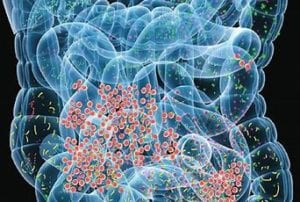Written by Joyce Smith, BS. Lactobacillus plantarum CCFM8610, a probiotic strain with both cadmium-binding and antioxidative abilities, demonstrated the ability to alleviate cadmium-induced cytotoxicity in the human cell line HT-29 and increase fecal cadmium levels and decrease Cd accumulation in the tissues of cadmium exposed mice.
 The heavy metal cadmium (Cd) is an environmental pollutant of our food and water and causes adverse health effects in both humans and animals 1,2. The intestinal tract is the first organ susceptible to cadmium’s toxicity 3; where Cd exposure causes disruption of the tight junction proteins of the intestinal barrier and allows increased intestinal permeability that induces inflammation and oxidative stress to vital organs of the body 4,5. Previous works by the authors have shown that L. plantarum CCFM8610 inhibits Cd adsorption in the intestines by binding with Cd before it is absorbed, thereby increasing Cd excretion as the lactobacillus strains are excreted in feces 6. In this study 7, researchers hypothesize that, in addition to binding Cd in the intestinal tract, probiotics prevent Cd absorption by protecting the integrity of the intestinal barrier.
The heavy metal cadmium (Cd) is an environmental pollutant of our food and water and causes adverse health effects in both humans and animals 1,2. The intestinal tract is the first organ susceptible to cadmium’s toxicity 3; where Cd exposure causes disruption of the tight junction proteins of the intestinal barrier and allows increased intestinal permeability that induces inflammation and oxidative stress to vital organs of the body 4,5. Previous works by the authors have shown that L. plantarum CCFM8610 inhibits Cd adsorption in the intestines by binding with Cd before it is absorbed, thereby increasing Cd excretion as the lactobacillus strains are excreted in feces 6. In this study 7, researchers hypothesize that, in addition to binding Cd in the intestinal tract, probiotics prevent Cd absorption by protecting the integrity of the intestinal barrier.
The study consisted of two parts: an in vitro cell analysis and a mouse model to evaluate and compare the effectiveness of three probiotics to protect the tight junction barrier. Results of the in vitro assay testing three L. plantarum strains (CCFM8610, CCFM11, and CCFM8614) against HT-29 cell (a human colon adenocarcinoma cell line) revealed that co-treatment with Cd and the CCFM8610 strain significantly reduced Cd-induced toxicity (36%), inhibited inflammatory cytokines and chemokines (TNF-α, IL-1ß, and IL-6), inhibited ROS generation, and decreased MDA levels, thus indicating CCFM8610’s superiority in reversing tight junction damage (P< 0.05 for all) compared to the control.
To further validate that probiotics not only bind Cd in the intestinal tract, but also inhibit intestinal Cd absorption by protecting the intestinal barrier, the same three L. plantarum strains (CCFM8610, CCFM11, and CCFM8614) were orally administered to Cd exposed C57BL/6 mice. Compared to the control (the group of mice receiving only Cd), L. plantarum CCFM8610 treatment significantly increased fecal Cd levels, decreased hepatic and renal Cd levels, reversed the mRNA expression levels of intestinal tight junction proteins, mitigated the increased levels of intestinal cytokines and chemokines and decreased gut permeability in the Cd exposed mice. (p<0.05). While CCFM8610 and CCFM11 treatment was also effective, significance was not reached.
This study demonstrates that probiotic treatment can reduce Cd-induced cytotoxicity, alleviate oxidative stress and inflammation, reverse tight-junction disruption, and decrease the gut permeability in both intestinal epithelial cells and animals. Further evidence for gut barrier protection was an increase in fecal Cd levels and a decrease in Cd accumulation in the tissues of the cadmium-exposed mice, indicating that probiotics inhibited intestinal absorption of Cd.
The authors conclude that the tested L. plantarum probiotic strains initially bind with Cd in the intestine, and additionally, due to their antioxidative ability, they also protects the integrity of the gut barrier. L. plantarum with its good Cd-binding and antioxidative capabilities may, with further investigation, potentially qualify as a daily supplement for the prevention of damage due to oral Cd exposure.
Source: Zhai, Qixiao, Fengwei Tian, Jianxin Zhao, Hao Zhang, Arjan Narbad, and Wei Chen. “Oral administration of probiotics inhibits absorption of the heavy metal cadmium by protecting the intestinal barrier.” Appl. Environ. Microbiol. 82, no. 14 (2016): 4429-4440.
Copyright © 2016, American Society for Microbiology. All Rights Reserved
Posted March 27, 2019.
Joyce Smith, BS, is a degreed laboratory technologist. She received her bachelor of arts with a major in Chemistry and a minor in Biology from the University of Saskatchewan and her internship through the University of Saskatchewan College of Medicine and the Royal University Hospital in Saskatoon, Saskatchewan. She currently resides in Bloomingdale, IL.
References:
- Hong F, Jin T, Zhang A. Risk assessment on renal dysfunction caused by co-exposure to arsenic and cadmium using benchmark dose calculation in a Chinese population. Biometals : an international journal on the role of metal ions in biology, biochemistry, and medicine. 2004;17(5):573-580.
- Thompson J, Bannigan J. Cadmium: toxic effects on the reproductive system and the embryo. Reproductive toxicology (Elmsford, NY). 2008;25(3):304-315.
- Nordberg G, Fowler B, Nordberg M, Friberg L. Handbook of the the Toxicology of Metals, 3rd edition. 3rd edition ed: Academic Press; 2007.
- Zhao Z, Hyun J, Satsu H, Kakuta S, Shimizu M. Oral exposure to cadmium chloride triggers an acute inflammatory response in the intestines of mice, initiated by the over-expression of tissue macrophage inflammatory protein-2 mRNA. Toxicology Letters. 2006;164(2):144-154.
- Ninkov M, Popov Aleksandrov A, Demenesku J, et al. Toxicity of oral cadmium intake: Impact on gut immunity. Toxicology Letters. 2015;237(2):89-99.
- Breton J, Le Clere K, Daniel C, et al. Chronic ingestion of cadmium and lead alters the bioavailability of essential and heavy metals, gene expression pathways and genotoxicity in mouse intestine. Arch Toxicol. 2013;87(10):1787-1795.
- Zhai Q, Tian F, Zhao J, Zhang H, Narbad A, Chen W. Oral Administration of Probiotics Inhibits Absorption of the Heavy Metal Cadmium by Protecting the Intestinal Barrier. Appled and Environmental Microbiology. 2016;82(14):4429-4440.
